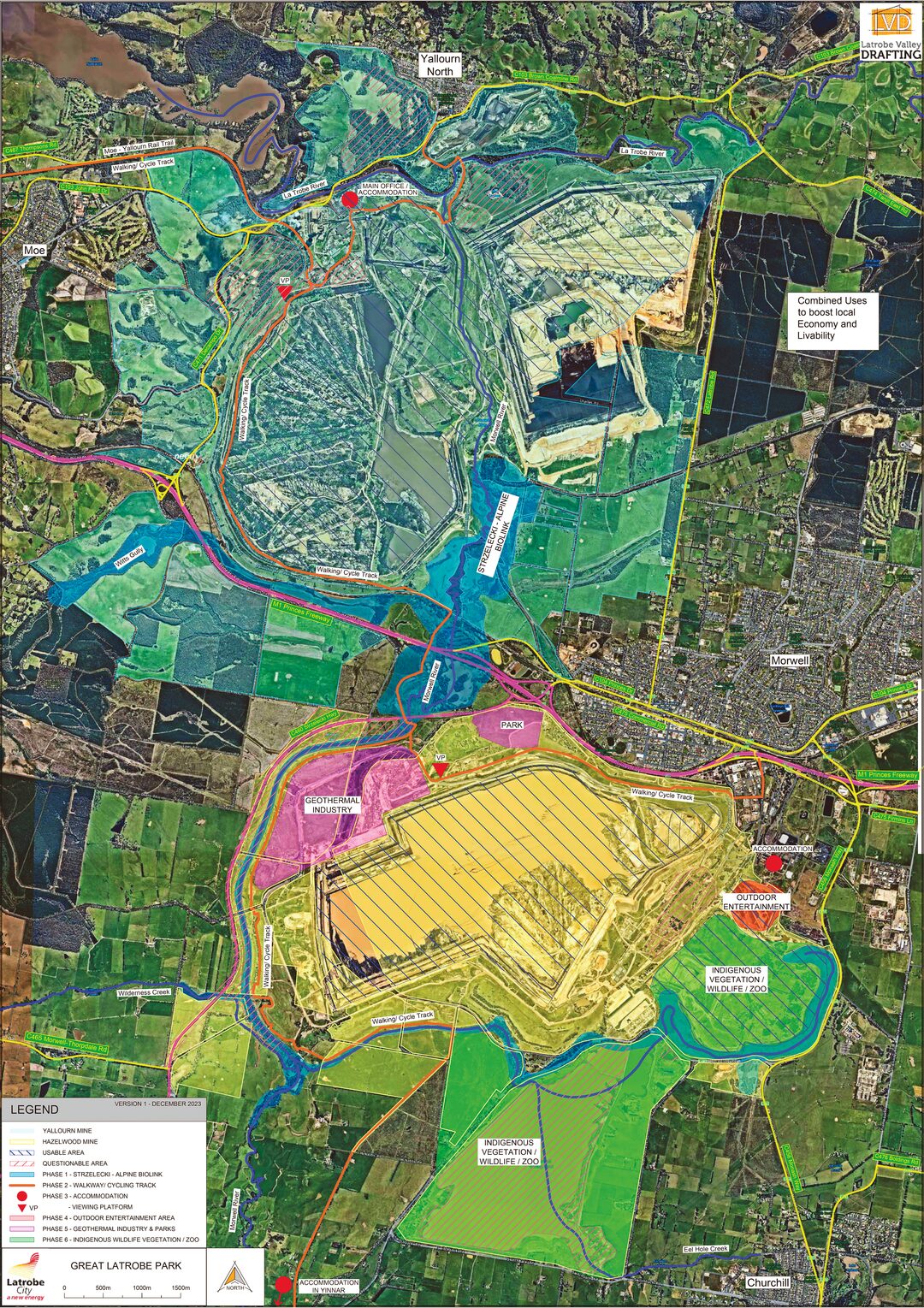By PHILIP HOPKINS
A GROUP of prominent Latrobe Valley residents, fearful of the dramatic economic and social impact on the region when the brown coal power plants close, has forged a vision of a revitalised economy based on new industry in a dramatically transformed physical environment.
The Great Latrobe Park (GLP) committee is pushing for a prominent Australian to lead the concept in order to unify the various, uncoordinated government measures and companies involved in rehabilitation plans for the Valley’s brown coal mines.
GLP president, Nina Burke, said there were many possibilities to repurpose the Valley, but these needed to be identified before rehabilitation plans are put in place.
“These need to be quantified and prioritised. This is planning that could, and should, be undertaken now,” Ms Burke told the Express.
More than 25 interested parties are involved in plotting the Valley’s future. These range from the mining companies, the regulators, federal and state government authorities, local government, water authorities, and industry and community groups.
“GLP has spent two years to get several of these parties to step up and take a leadership role but has been unsuccessful. There is a leadership vacuum on repurposing,” Ms Burke said.
“The all-important role of leadership cannot be fulfilled from within the Latrobe Valley and that only an eminent Australia will have a chance of bringing all of the players together to create a single agreed plan for advancing repurposing.”
The GLP committee, formed in 2018, is driven by people with decades of Latrobe Valley experience in mining, engineering, regional planning, health and community services, agriculture and education. These include Richard Polmear, a civil engineer with 34 years in the brown coal mining industry; Rob Gaulton, who for 25 years was the principal on-site geologist at the State Electricity Commission’s Valley mining operations; David Langmore, a former Gippsland regional planner; Barbara Johnson, an agricultural scientist and a former chair of the West Gippsland Catchment Management Authority; Ross Harford, an economist and a former strategist for the Liberal Party in Victoria; and Brendan Wilkinson, an IT specialist with an MBA and Master of Engineering and former manager at Australian Paper’s Maryvale Paper Mill.
Many hundreds of direct and indirect jobs will be lost when the power stations close, with fears the Valley’s gross regional product will decline by more than 16 per cent, and that more than 10 per cent of current jobs, adding up to more than $170 million in current wages and salaries being lost. Households will not have this money to spend locally, hitting shops and associated businesses, damaging confidence and perceptions of the region.
Ms Burke said the economic impacts were significant and likely to negatively affect many within the Latrobe Valley and potentially damage the social fabric.
“What is needed is replacement of the lost economic asset by one or more economic assets of equal value whilst addressing underlying social-economic disadvantage,” she said.
However, the task is massive. Ms Burke emphasised that the area, depth and volume of each mine was unprecedented in Victoria. The full pit lakes by 2047 would contain up to 2685 gigalitres of water – almost six times Melbourne’s annual water usage in 2023-24, and more than two-and-a-half times the capacity of the Thomson Reservoir.
“It has never been done before on this scale in the world. The degree of difficulty is unprecedented as it includes not just one mine, but three interconnected mines and involves many parties with potentially conflicting interests,” Ms Burke said.

With the power stations gone and the mines filled with water, GLP believes the Valley’s image could be revitalised with appropriate access, attractive scenery, tourism, commercial and liveability drawcards established on the mine lands.
Ms Burke said changing the landscape between the Princes Freeway bypass of Morwell and the Hazelwood mine would substantially improve the aesthetic image of the Latrobe Valley.
“Additionally, GLP believes that Morwell township needs to be physically connected to the Hazelwood mine via an extension of either Hazelwood Road or Tarwin Street over the Princess Freeway bypass of Morwell,” Ms Burke said.
GLP said a geothermal resource had the potential to generate new businesses. Artesian water under the Hazelwood mine is extracted to maintain mine stability, but the heat energy is not captured or used.
“Heat energy within the artesian waters can sustain alternate industries,” Ms Burke said, with Melbourne University conceptualising smart geothermal industrial loops.
“Major supermarkets, for example, may be interested as this potentially assists in their push to be CO2 neutral. The heat energy could also be used in an up-market spa/resort activities. These examples can only be realised with progressive relinquishment of mine lands for repurposing. This requires mine repurposing working in parallel with mine rehabilitation.”
Tourism is a key plank in GLP’s vision for economic growth, with improved liveability essential for population growth.
“If the sites are considered ‘ugly’, no one will want to visit or live in the Latrobe City Council area,” Ms Burke said.
“The Yallourn site is the logical site to display the engineering history and heritage of brown coal mining and power generation.” This could include a geological, Indigenous and early settlers museum; a museum documenting the rise and fall of the SEC; and a museum celebrating Sir John Monash as the previous Yallourn main office, in which Monash had an office. Related to this are visitor viewing points; which Engie Hazelwood and EnergyAustralia Yallourn have both nominated sites, but GLP urges other companies to do the same thing, including monuments to workers.
Beautifying the Valley is crucial to GLP’s plan, which praises Latrobe City Council’s pathways and biolink concepts. Pedestrian and cycling pathways would interconnect towns within Latrobe City.
Ms Burke said the critical question was whether these paths would be mainly for commuting – the shortest route – or a more meandering, aesthetic experience.
“GLP’s view is that both should be considered with areas of commonality. GLP would also like to see visitor vantage points, memorials and visitor points on the pathways,” she said.
The Strzelecki-Alpine Biolink aims to provide corridors of vegetation for target species to allow them to move between the Strzelecki Ranges to the south and Alpine region to the north of the Latrobe Valley. An option is to use the Morwell River, its floodways and tributary drainage lines.
GLP says defining the proposed alignments for biolinks that run through the mine lands should be a pre-condition to do the pathways design.
GLP has been working with Latrobe Valley Field Naturalists to identify high environmental values and what levels of protection may be needed, access arrangements and how to make money by providing a high value experience.
Other options include:
- Plantings of deciduous flora with autumn colours, avenues of deciduous trees, commercial vineyards that run down to the edge of the mine lakes, or unusual plantings such as fire retardant Californian Redwoods as a potential tourist drawcard;
- An outdoor entertainment hub, or a white water park across the ridge of the eastern batters of the Hazelwood mine. It could use the top-up water supply needed for the Hazelwood mine water level so as to operate at reduced costs;
- Creation of a Gippsland Wildlife carers native animal hospital off Monash Way with access to a new ‘Healesville-style’ park at the northern end of the Hazelwood eastern overburden dump;
- Sowing native grasses on the 500ha-plus site of the Hazelwood Cooling Pond to support boutique farms of unique grains, and;
- With such large land areas available, model pig, beef and dairy farms could be developed.











